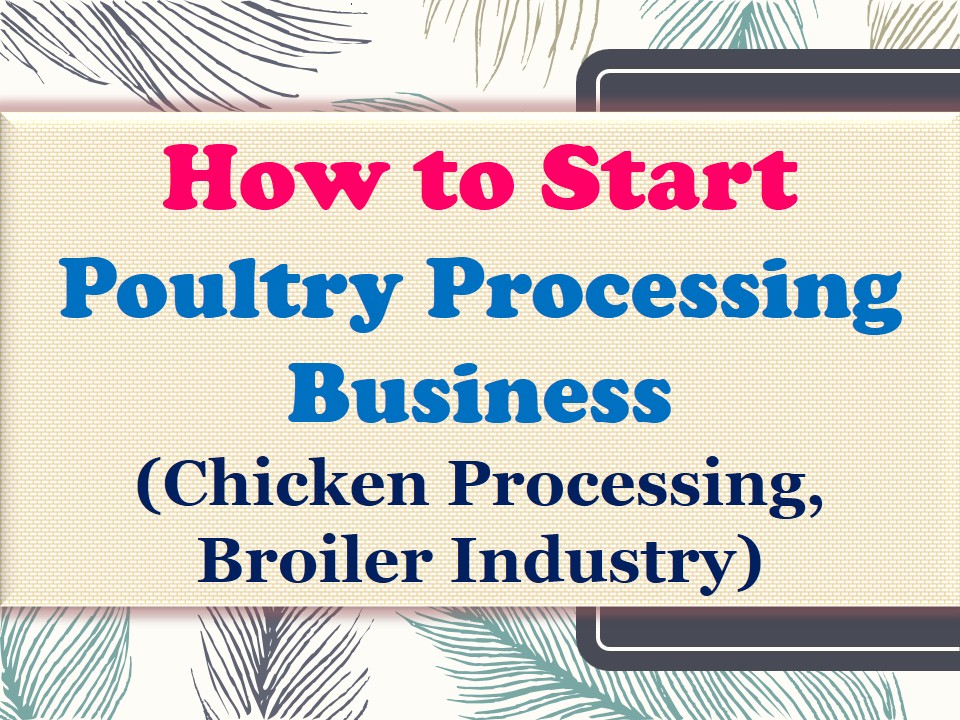
Starting a poultry processing business can be a rewarding and profitable venture. With increasing demand for hygienically processed chicken, turkey, and other poultry products, the industry is growing at a fast pace. It serves a wide range of customers, from local meat shops and supermarkets to hotels and restaurants. However, to succeed in this field, proper planning, investment, and adherence to regulations are critical.
See Also : lucrative project profiles
Why Start a Poultry Processing Business?
The poultry industry continues to expand globally, offering consistent demand for processed meat. Consumers are shifting towards packaged, clean, and ready-to-cook chicken over live bird purchases. Moreover, the poultry processing business bridges the gap between poultry farms and the consumer market, offering excellent opportunities for entrepreneurs. With technological advancements and supportive government policies, setting up such a unit is much easier today than it was a decade ago.
To begin with, one must first understand the essential requirements for this business. Market research, legal compliance, equipment setup, skilled labor, and hygienic infrastructure are key components. Additionally, you must ensure sustainable waste disposal, cold chain management, and effective packaging to maintain quality and extend shelf life.
First, let’s look at the steps involved in launching a poultry processing business.
Step 1: Conduct Market Research and Feasibility Study
Before making any investment, understand your target market. Analyze local demand, existing competitors, customer preferences, and pricing structures. This helps in designing your services better than your competitors. Visit poultry farms, wholesalers, retailers, and understand their sourcing patterns.
If you plan to start on a small scale, target a specific area with high meat consumption. Alternatively, for a medium or large-scale unit, ensure access to transportation, logistics, and a wider supply chain.
A feasibility report will also help identify risks, evaluate the return on investment, and prepare for financial planning. Make sure to include data on raw poultry availability, distribution costs, potential sales volume, and operational expenses.
Step 2: Choose the Right Business Model
Decide whether you want to operate a standalone poultry processing unit or integrate it with a poultry farm. The standalone model involves sourcing live birds from local farms and then processing them. This allows flexibility in sourcing but increases procurement costs. An integrated model gives more control over bird quality and cost, but it requires a larger investment.
You can also opt for a B2B (business-to-business) or B2C (business-to-consumer) approach. Supplying to restaurants, catering services, and meat shops is a solid B2B model. Selling packaged chicken through your own brand or outlets targets the B2C market.
Evaluate what model fits your vision, funding, and location before proceeding.
Step 3: Legal Compliance and Registration
Every poultry processing business must comply with local and national food safety standards. In India, you need to register with FSSAI (Food Safety and Standards Authority of India) and obtain a food processing license. GST registration, trade license, factory license, and pollution control certificates are also essential.
If you plan to export poultry products, get necessary approvals from APEDA and other export agencies. Meeting hygiene standards, quality certifications, and cold chain audits are mandatory.
Hire a legal advisor or consultant to streamline documentation. Delays in licensing can affect your business timeline and customer trust.
Step 4: Site Selection and Infrastructure
The location of your unit plays a key role in logistics and profitability. Choose a site near poultry farms to reduce transportation time and live bird mortality. Ensure the location is compliant with zoning regulations and far from residential zones to avoid complaints.
Your poultry processing unit must have proper slaughtering space, chilling rooms, cutting areas, packaging zones, and waste disposal units. Additionally, set up a quality control lab, water treatment area, and cold storage.
Invest in stainless steel equipment that meets hygiene standards. Smooth flooring, proper drainage, insect-proofing, and ventilation are critical for maintaining cleanliness and efficiency.
Step 5: Equipment and Technology
Processing equipment is the backbone of the poultry processing business. Depending on your scale, invest in semi-automatic or fully automatic machines. Key equipment includes:
-
Defeathering machines
-
Evisceration tools
-
Meat cutting machines
-
Chillers and freezing units
-
Vacuum packaging machines
-
Conveyor belts
-
Waste treatment systems
Automation not only improves productivity but also ensures uniform quality. However, for a small-scale setup, manual processing with minimal automation can also work. Make sure the machinery complies with safety norms and is easy to maintain.
Step 6: Hire Skilled Staff and Train Them
A well-trained workforce ensures efficient operations and product quality. Hire staff with experience in slaughtering, meat handling, hygiene control, packaging, and logistics. You’ll also need supervisors, maintenance technicians, quality inspectors, and administrative staff.
Provide training on food safety, sanitation, machine handling, and first aid. Conduct regular audits and safety drills to maintain a disciplined and hygienic workplace. Additionally, using protective gear and following ethical slaughtering practices builds a good brand image.
Step 7: Focus on Hygiene and Waste Management
Maintaining hygiene is not optional in the poultry processing business. Daily cleaning of the facility, sterilization of tools, and proper disposal of feathers, blood, and waste must be part of the routine. Untreated waste can cause health hazards and damage your brand reputation.
Install effluent treatment plants (ETPs), odor control systems, and composting or rendering units. You can also generate value by converting waste into poultry feed additives or fertilizers.
Cold chain management is equally important. Processed meat must be quickly chilled or frozen to avoid bacterial growth. Use temperature-controlled trucks for delivery and ensure your supply chain remains uninterrupted.
Step 8: Branding, Marketing, and Distribution
In today’s competitive market, packaging and branding make a major difference. Design attractive packaging that includes expiry date, weight, nutritional info, and cooking tips. This helps customers trust your brand.
Launch a website, social media pages, and list your products on online marketplaces. Offer discounts, hygiene certifications, and delivery options to attract more buyers. Build a network of distributors and negotiate shelf space in supermarkets.
Use digital marketing tools such as Google Ads, Facebook promotions, and influencer marketing to reach more customers. Offering fresh, tender, and antibiotic-free chicken can set your brand apart.
Step 9: Financial Planning and Funding
Starting a poultry processing business involves substantial investment. Costs include land, construction, equipment, staff salaries, licenses, and working capital. Prepare a detailed business plan and financial projections for at least 3–5 years.
You can fund your project through personal savings, bank loans, angel investors, or government schemes. In India, schemes like PMEGP, Mudra Loan, and NABARD subsidies support food processing units. Be ready with proper documents and collateral to secure funding.
Maintain detailed records of your income, expenses, inventory, and taxes to manage your business efficiently and attract future investors.
Step 10: Expand and Innovate
Once your poultry processing business gains stability, plan to scale. You can diversify into ready-to-eat chicken snacks, marinades, sausages, or value-added products. This helps increase profit margins and brand recognition.
Introduce mobile vans, franchise models, or cloud kitchens to reach new markets. Explore international markets, attend food expos, and stay updated on new food technologies.
Innovation and responsiveness to customer feedback will keep your business relevant and profitable in the long run.
See Also : Business Ideas and Startup Opportunities
Conclusion
Starting a poultry processing business requires dedication, strategic planning, and regulatory compliance. However, the rewards are high with consistent demand and evolving consumer habits. From choosing the right equipment to maintaining hygiene, each step plays a crucial role in the success of your venture.
This sector continues to grow with urbanization, health-conscious consumers, and rising non-vegetarian food consumption. If you stay committed to quality and build a reliable supply chain, your poultry processing business can become a highly rewarding enterprise in the food industry.





